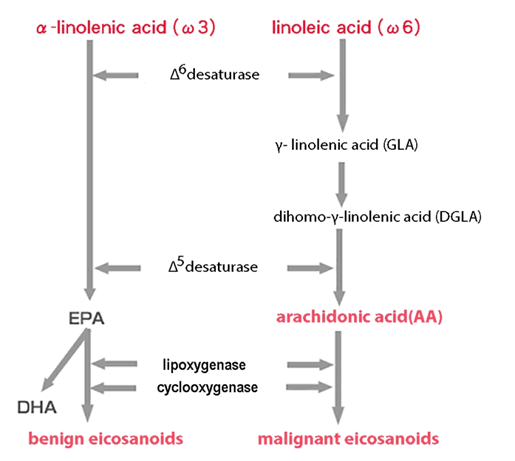Eicosanoid
Eicosanoid
The term ‘eicosanoid’ frequently appears on my website, so let’s offer a brief introduction.
Put simply, an “eicosanoid” is a potent, hormone-like substance originating from essential fatty acids within the cell membrane. It boasts a structure with 20 carbon atoms (hence its name, derived from the Greek word eikosi meaning 20). Think of it as a localized hormone.
The creation of eicosanoids is intimately tied to unsaturated fatty acids, particularly omega 3 (ω3) and omega 6 (ω6). These omegas differ based on the position of their carbon double bonds. For simplicity’s sake, we’ll forgo a technical deep-dive here.

Just as hormones like insulin and glucagon balance blood sugar through opposing actions, numerous eicosanoids continuously adjust to the microenvironments of adjacent cells and tissues, playing contrasting roles.
For ease of understanding, I categorize eicosanoids into two groups: those that induce inflammation (which I term “malignant”) and those that counteract it (“benign”). This classification might be broad, but it streamlines comprehension. In summary:
Effects of benign eicosanoids:
Anti-inflammatory, Vasodilation, Suppression of platelet aggregation, Enhancement of the immune system, Cancer suppression, Allergy symptom relief
Effects of malignant eicosanoids:
Inflammation promotion, Vasoconstriction, Promotion of platelet aggregation,Weakening of the immune system, Exacerbation of allergic symptoms
For clarity, let’s delve into eicosanoids. Prostaglandin E1, considered a benign eicosanoid, suppresses platelet aggregation and dilates blood vessels, aiding in the prevention of hypertension and cardiovascular diseases. On the other hand, thromboxane A2, labeled as a malignant eicosanoid, constricts blood vessels and promotes platelet aggregation. This dual action makes thromboxane A2 a contributor to heart and vascular diseases.
However, malignant eicosanoids serve essential roles. For instance, if you accidentally cut your finger, the bleeding won’t stop without the vasoconstrictive and platelet-promoting effects of thromboxane A2. Conversely, an excess of the benign eicosanoid prostaglandin E1 can dangerously lower blood pressure. But while we don’t injure ourselves daily, an unchecked vasoconstrictive effect from thromboxane A2 can lead to ailments like high blood pressure and myocardial infarction, labeling it “malignant”. Yet, in high-stress situations like battles, its effects can be beneficial, ensuring optimal blood pressure and clotting when injuries are likely.
The relationship between benign and malignant eicosanoids mirrors that of the sympathetic and parasympathetic nervous systems: both are vital. Still, an overdominance of malignant eicosanoids can result in health issues, including hypertension, myocardial infarction, stroke, lupus, asthma, arthritis, psoriasis, and even cancer. At the cellular level, diseases can be described as an eicosanoid imbalance or a chronic dominance of malignant over benign eicosanoids.
Both types of eicosanoids derive from ω3 and ω6-unsaturated fatty acids. Notably, malignant eicosanoids sourced from ω6’s arachidonic acid have more potent effects than their ω3 counterparts. Certain leukotrienes, which are associated with allergies, are also products of arachidonic acid and can be far more potent than histamine. In contrast, EPA from ω3-unsaturated fatty acids can prevent the metabolism of ω6 into arachidonic acid, promoting more benign eicosanoids.
It’s worth noting the distinction between alpha-linolenic acid (ω3) and linoleic acid (ω6). Foods rich in α-linolenic acid, such as flaxseed oil (including perilla oil and sacha inch oil), are beneficial. Fish (like krill) provides ω3 fatty acids, while most animal meats are high in linoleic acid.
In Brief:
Fish, Krill, Seal Oil ➔ EPA/DHA ➔ Benign eicosanoids
Flaxseed Oil, Perilla Oil➔ α-linolenic acid ➔ Benign eicosanoids
Animal meat ➔ linoleic acid ➔ Arachidonic acid ➔ Malignant eicosanoids
Caution
Many vegetable oils, including safflower, sunflower, corn, rapeseed, soybean, cottonseed, sesame, peanut, wheat germ, evening primrose, and grape seed oils, are linoleic acid-rich. Consume them sparingly.
Copyright: No reproduction or republication without written permission.
